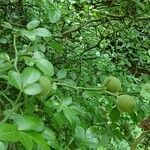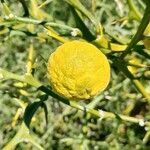Trees or treelets, 1-5 m tall. Branches green, flat, ridged when young; spines ca. 4 cm, base flat, apex rufous. Foliage spurs unarmed, developed from dormant buds on twigs of previous year, with very short internodes bearing 1-5 leaves. Leaves palmately 3(-5)-foliolate, in juveniles usually simple or 1-foliolate; petiole narrowly winged; leaflet blades 2-5 × 1-3 cm, central one as long or longer than laterals, midvein with short trichomes when young, margin finely crenulate or entire. Flowers solitary or paired, 3.5-8 cm in diam. Calyx lobes 5-7, basally connate. Petals (4 or)5(or 6), white, obovate, 1.5-3 cm, imbricate. Stamens usually 20; filaments of different lengths. Ovary 6-8-loculed, hairy; ovules 4-8, in 2 rows per locule; style short, thick; stigma clavate. Fruit dark yellow, subglobose to pyriform, usually 3-4.5 × 3.5-6 cm, with coarse ring-shaped furrows or sometimes smooth. Seeds 20-50, broadly ovoid, 0.9-1.2 cm; embryo(s) solitary or several; seed coat smooth or with inconspicuous fine ridges. Fl. May-Jun, fr. Oct-Nov.
More
A small to medium sized tree. It grows 2-4 m tall. It has many branches. It is thorny. It loses its leaves. The flower buds form in summer then over-winter on the bare branches. The flowers are white. They are 4-5 cm across. The fruit are small and like citrus. They become yellow when ripe.
The fruit are used for a syrup used for flavouring. The peel can be candied. The peel makes a spicy flavouring for cakes. The flesh is used for jellies. A drink can be made from the diluted juice. The fruit need to be kept for about 2 weeks to become juicy. Young leaves are occasionally boiled and eaten.


